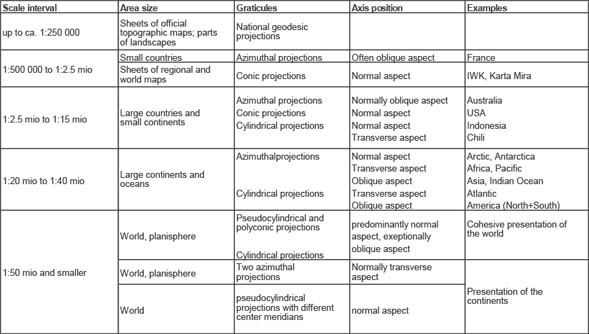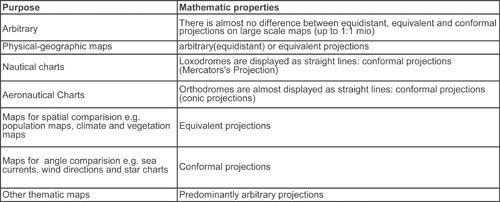Choice of the map projection
Often, the map projection is predetermined. If it is not predetermined, a lot depends on the map size, the scale, shape and location of the region of interest on the globe. Depending on the purpose, equivalent, conformal and compromising projections are used. However, a high degree in equivalence results in a high degree of angle distortion and a high degree of conformance results in a high degree of areal distortion. Therefore, a projection between these extremes is sought, which ideally possesses small distortions. Possibly, compromising projections can be of interest, which for example possess equidistant circles of latitude or which preserve proportional distances. If comparisons of areas are important for small scales, equivalent projections are preferred.
Choice of the projection depending on scale and map size
The following table provides an overview over the choice of the projection depending on scale and size of the area.
 Source: according to Hufnagel 1998 in (Klauer 2000)
Source: according to Hufnagel 1998 in (Klauer 2000)Choice of the projection depending on shape and location of the area
To achieve minimal distortions on the map, different map projections are preferred depending on the shape and location of the area. The following table shows the categorization into the three main design types. These are valid in particular for small to medium sized areas. It becomes more difficult when depicting greater areas, where usually compromise projections are used.
 Source: according to Hufnagel 1998 in (Klauer 2000)
Source: according to Hufnagel 1998 in (Klauer 2000)Choice of the projection depending on topic
Depending on the topic of the map, conformal (for nautical and navigational maps) or equal-area (for distribution maps) projections are preferred or are even inevitable for the map to serve its purpose. However, to avoid distortions compromising maps are suited best.
 Source: according to Hufnagel 1998 in (Klauer 2000)
Source: according to Hufnagel 1998 in (Klauer 2000)